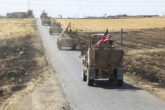June 04, 2019
What a War With Iran Would Look Like
Neither Side Wants a Fight, but That Doesn’t Eliminate the Danger
Tensions between Iran and the United States are at their highest point in years. The 2015 Iran nuclear agreement is teetering. The Trump administration is using sanctions to strangle the Iranian economy and in May deployed an aircraft carrier, a missile defense battery, and four bombers to the Middle East. Washington has evacuated nonessential personnel from its embassy in Baghdad, citing intelligence suggesting that Iran is increasingly willing to hit U.S. targets through its military proxies abroad.
The United States also stated that Iran almost certainly perpetrated the recent damage to oil tankers flagged by Saudi Arabia, Norway, and the United Arab Emirates (UAE) and claimed that Iran had temporarily loaded missiles onto small boats in the Persian Gulf. In early May, U.S. National Security Adviser John Bolton publicly threatened a response to any Iranian attacks, “whether by proxy, the Islamic Revolutionary Guards [sic] Corps or regular Iranian forces.”
The good news is that the situation is not as bad as it appears. None of the players—with the possible exception of Bolton—seem to really want a war. Iran’s military strategy is to keep tensions at a low boil and avoid a direct confrontation with the United States. Washington struck a tough public posture with its recent troop deployment, but the move was neither consequential nor terribly unusual. If the United States were truly preparing for a war, the flow of military assets into the region would be much more dramatic.
Read the full article in Foreign Affairs.
More from CNAS
-
Proxy battles: Iraq, Iran, and the turmoil in the Middle East
Since Hamas’s attacks sparked the war in Gaza on 7 October 2023, a dangerous cycle of escalation has played out across the Middle East. Iran and its proxies – such as the Hout...
By Hamzeh Hadad
-
What Comes Next for the U.S. in the Middle East
Following a fatal attack on U.S. troops in Jordan, Jonathan Lord analyzes what comes next for the U.S. Watch the full interview with NBC News....
By Jonathan Lord
-
Biden Needs to Deal with China’s Ever-Closer Ties to Iran
Iran and China’s growing relationship is no longer a “what-if,” but a “what-do-we-do-now.”...
By Arona Baigal & Kiana Alirezaie
-
Why U.S.-Iran Tensions Are On The Rise In The Persian Gulf
Over the last decade, Iran has been causing more and more headaches for oil tanker operators in the Strait of Hormuz, a central artery of global trade. In the last two years a...
By Arona Baigal




